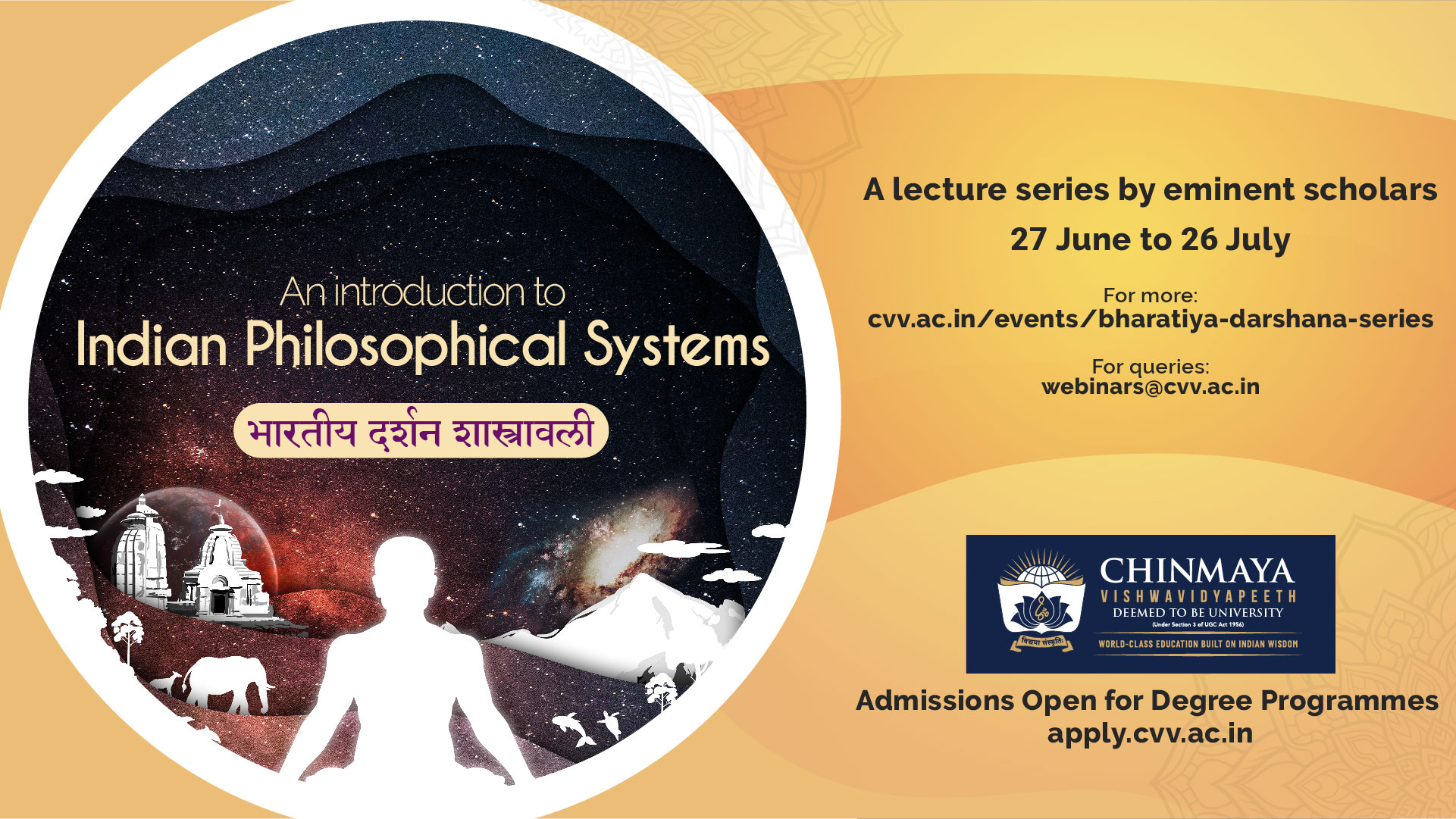On 27 June 2020, Chinmaya Vishwavidyapeeth launched a lecture series by eminent scholars on भारतीय दर्शन शास्त्रावली or ‘Bhāratīya Darśana Śāstrāvalī’—An Introduction to Indian Philosophical Systems.
The series was inaugurated with the blessings of Swami Sharadananda, who said that Darśana śāstra came as a means to ‘remove sorrow’ and ‘attain happiness—eternal bliss!’ Dean of CVV, Dr. Gauri Mahulikar briefly introduced the topic of ‘Bhāratīya Darśana’. Both the dignitaries set the tone for the entire series.
The moderator for the series is Shri Subramanian Chidambaran, an Engineer with a PG in Management, IIM Lucknow, working as Head of Strategy at an MNC in Mumbai. He has a Masters in Sanskrit and is a trained Carnatic musician. A student of Dean Mahulikar, Shri Subramanian has played a major role in organising this lecture series and coordinating with the speakers.
Below is a synopsis of each lecture.
Session 1: ‘Introduction to the world of Darśana Śāstra’ by Dr. Tulasi Kumar Joshi
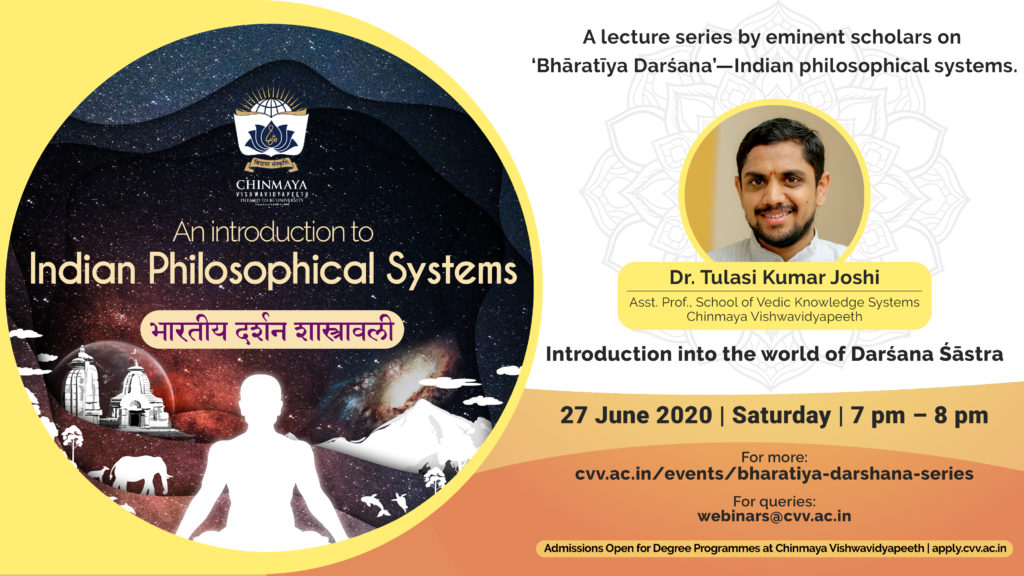
Dr. Joshi took the listeners through the meaning of Darśana right from its etymological basis to its definition as a ‘valid visual perception or cognition’ and also ‘the means to achieve it’. Thus valid cognition of ‘happiness’ and ‘means to remove sorrow’ became the subject matter of Darśana śāstra. In order to achieve this, different systems (under the guidance of different Ṛṣi-s/seers) accepted different forms of ‘valid cognition’ and propounded their principles for ‘achieving happiness’ and ‘removing sorrow’. This led to different systems of Darśana. Those that accepted the authority of the Vedas came to be called ‘Āstika Darśana’ and those that denied were called ‘Nastika Darśana’.
Session 2: ‘Indian Materialism: Lokāyata’ by Dr Shubhada Joshi
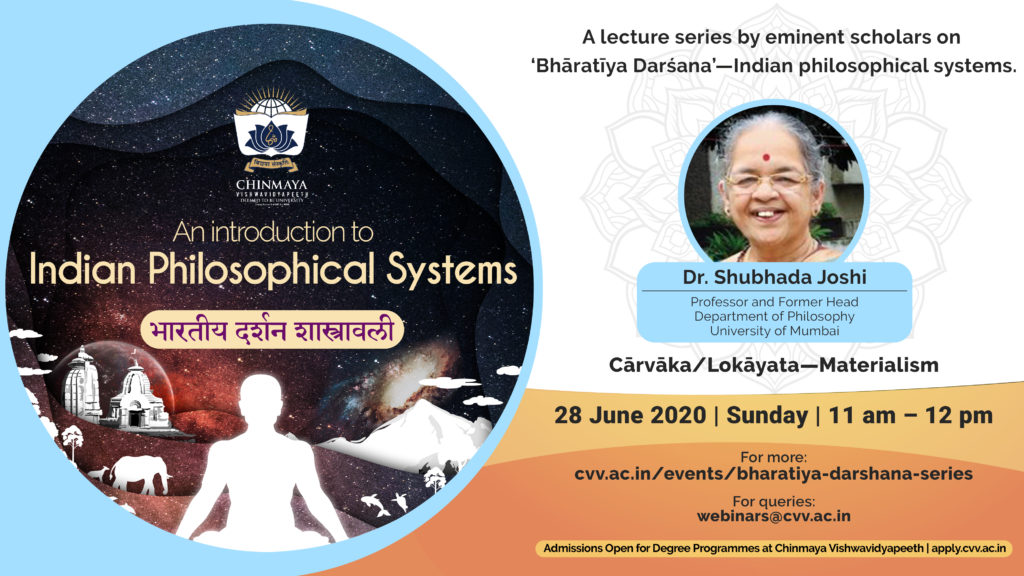
Dr. Joshi provided a balanced narrative on this ‘much maligned’ school of Indian philosophy. She brought out the point that Lokayata was accorded a very respectable place in early Indian culture, of the times of Mahābhārata and even up to the Mauryan empire. The Arthaśāstra of Kauṭilya prescribes the syllabus for an upcoming prince thus: आन्वीक्षिकी त्रयी वार्त्ता दण्डनीतिश्च इति विद्याः. It includes ānvīkṣikī (philosophy), trayī (threefold Vedas – Rig, Yajur, Sama) vārttā (economics / agriculture), daṇḍanīti (science of governance and justice). Under philosophy, it lists only three subjects: Sāṅkhya, Yoga and Lokāyata – साङ्ख्यं योगो लोकायतं च इत्यान्वीक्षिकी. Other schools like Nyāya and Vedānta are not mentioned at all.
The professor explained the significance of this in a wonderful way. There is also mention in Mahābhārata (Vana Parva) in which Draupadi says she learnt Barhaspatya (teaching from Braihaspati, another name for Lokāyata) from the learned scholars in the court of her father Drupada while growing up.
At the end of the session and during Q & A, Dr. Joshi outlined the merits and demerits of the Lokāyata outlook in a very balanced way. She pointed out that much of the progress in material science in ancient India like Ayurveda, astronomy, mathematics etc. was due to the respect accorded to analytical/critical thinking and questioning everything. She also elucidated on the intellectual insufficiency of Lokāyata epistemology pointing out that even modern science relied a lot on inference (anumāna) and also the ethical/moral degeneration wrought by a pure materialist outlook.
Session 3: ‘Nyāya Darśana—The Science of Logic in Indian Philosophy’ by Dr. V. N. Jha
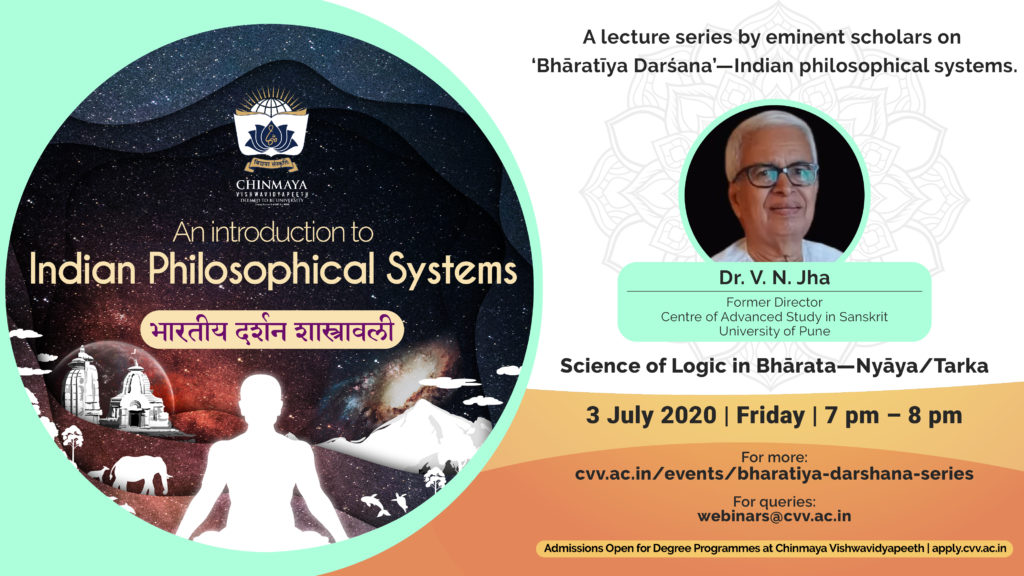
Prof. V. N. Jha was the Director, Centre of Advanced Study in Sanskrit, University of Pune where he taught for more than 25 years. He was also the founding Chairman of the Special Centre for Sanskrit Studies, Jawaharlal Nehru University, New Delhi.
Prof. Jha beautifully explained the evolution of Nyāya śāstra right from the Nyāya-sutras of Gautama and the Arthaśāstra of Kauṭilya. He explained how Nyāya formed a critical part of the scholarship triad ‘Pada (grammar/Vyākaraṇa)—Vākya (discourse by Pūrva-mīmāṃsā)—Pramāṇa (Logic/ Nyāya)’. He emphasised that the concept of ‘Knower-Knowing-Known and knowledge’ explained by Nyāya forms the basis of the science of ‘Knowledge’ and is most fundamental for understanding anything in the Universe.
While Prācīna-Nyāya focused on the ‘Knowable’, Navya-Nyāya (post 10th century CE) focused on developing an entire system on ‘Methods/ instruments of knowing’ and a suitable language to represent them. Most of the other Darśana śāstra texts are written in the language of ‘Navya-Nyāya’.
‘Anumāna’ or inference as a means of knowledge is another great contribution of ‘Nyāya’ without which a lot of what we know would be nearly impossible. Though Nyāya and Vaiśeṣika systems differ in aspects like ‘Īśwara’ and ‘Abhāva’, they merged post 10th century CE developing a common universal view.
Prof. Jha repeatedly emphasised the fact that Nyāya śāstra forms the basis of all ‘knowledge’ and ‘research’ activities and hence must be a mandatory subject introduced at the primary and other levels of education.
Session 4: ‘Vaiśeṣika Darśana—The Atomic View of the Universe in Indian Philosophy’ by Dr. Rajeshwar V. Deshmukh
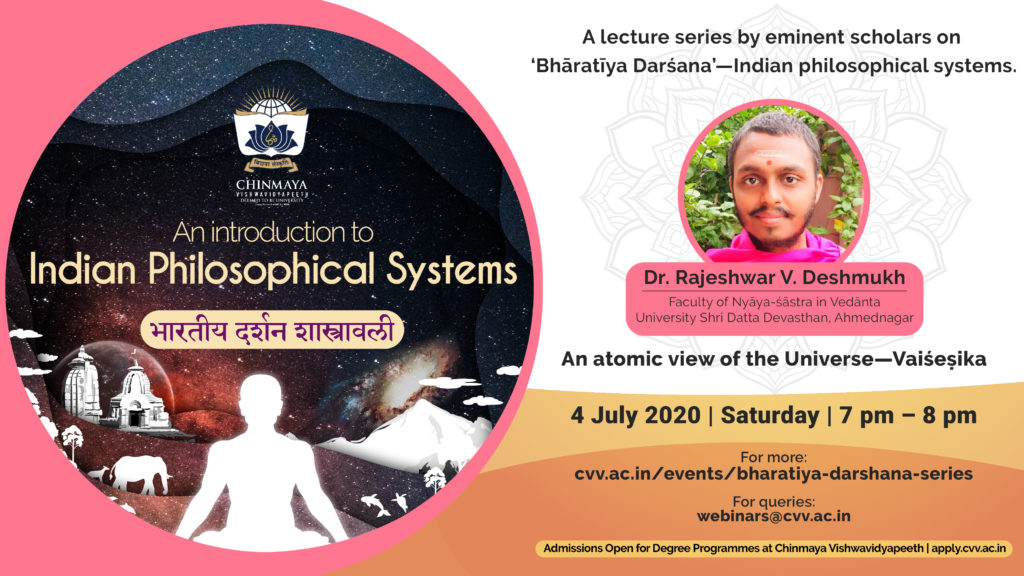
Dr. Deshmukh has a doctorate in Nyāya Śāstra and also a faculty of Nyāya Śāstra in Vedānta University Shridattadevasthan, Ahmednagar. He has been honoured with several awards. He has participated in several Vākyārtha Sadas/Sabhās’ including the one at Sringeri.
While maintaining the view that Nyāya-Vaiśeṣika system is viewed as a single system today, he brought out the key contributions of the Vaiśeṣika system.
1) The 16 categories of padarthas of the Nyāya system are brought down to seven in the Vaiśeṣika (Dravya, Guṇa, Karma, Samanya, Viśeṣa, Samavaya and Abhāva). Of these, the Viśeṣa i.e. ‘particularity’ is a distinct contribution of this system and hence the system itself came to be called Vaiśeṣika. It is this Viśeṣa that distinguishes one thing from another.
2) To understand what exactly is different, they delved into the basic components of every padartha which they called paramāṇu which is the smallest indivisible part.
4) They believe that the four bhūtas (Earth, Water, Fire and Air) are destructible and therefore temporary (anitya). Hence, all destructible things in the universe are created from the Paramāṇu of these four elements.
5) They then explained the interaction between these Paramāṇu-s and the formation of different things in the world. They also said that the presence of ‘teja’ (teja samyoga) was the cause of all transformation (e.g. the grass eaten by a cow turning into milk through the action of the digestive fire etc.)
6) Paramāṇu by themselves are ‘acetana’ (insentient) and hence they by themselves cannot interact with each other. They are made to interact by an unknown force they called adṛṣṭa which is an aspect of the ‘Ātman’.
7) Ākāśa (space), Mind, Ātman, Time and Space are indestructible and hence permanent (nitya).
8) Mokṣa or liberation as per this darsana is to know that Ātman is different from the five elements and is Nitya.
The speaker beautifully focused on the unique contributions of Vaiśeṣika Śāstra in very simple and fluent Hindi that made the listening enjoyable!
Session 5: A View of Cosmology and the Concept of Triguṇa—Sāṅkhya’ by Dr. Madhusudan Penna.
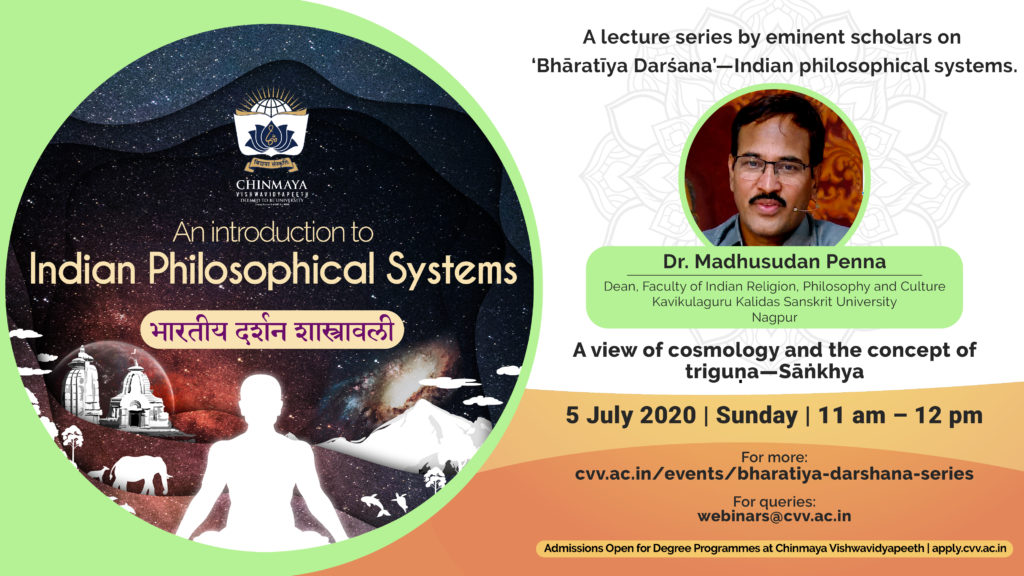
Day 5 of the ‘Bhāratīya Darśana Śāstrāvalī’ series, 5 July, was indeed special as it coincided with Guru Pūrṇimā. The day also featured two sessions by eminent scholars.
The morning session was by Dr. Madhusudan Penna. Dr. Penna is the Dean, Faculty of Indian Religion, Philosophy and Culture, Kavikulaguru Kalidas Sanskrit University. He has received prestigious awards like the Somnath Trust Gold Medal and Award, Pt. Satwalekar Award and many more. With thirty books and 35 articles to his credit, including two Mahakavya—of which one the ‘Pradnyachakshum’ won the Sahitya Academy Award in 2019.
Salient features of the Darśana he enumerated were:
1) Prakṛiti and Puruṣa are the two realities. Prakṛiti is the entire cause of creation but is inert and becomes active on contact with Puruṣa, who is consciousness.
2) Prakṛiti generates the three guṇas (Sattva, Rajas, Tamas) which later create mahat (collective ego), Ahaṅkāra (individual ego), the five sense organs of knowledge, action, mind, the pañca-bhūtas etc. Thus, creation comes into being.
3) All three guṇas are in equilibrium in Prakṛiti. When this equilibrium is disturbed, creation starts.
4) When Puruṣa comes outside the influence of Prakṛiti, it is called mokṣa or liberation
All in all an enlightening exposition on Sāṅkhya—one of the oldest darśana (called ‘Vṛddha’ by Sri Śaṅkara) that is used by most of the later darśanas to explain creation.
Session 6: ‘Īśwara—God in Indian Philosophy’ by Dr. Srinivas Varakhedi
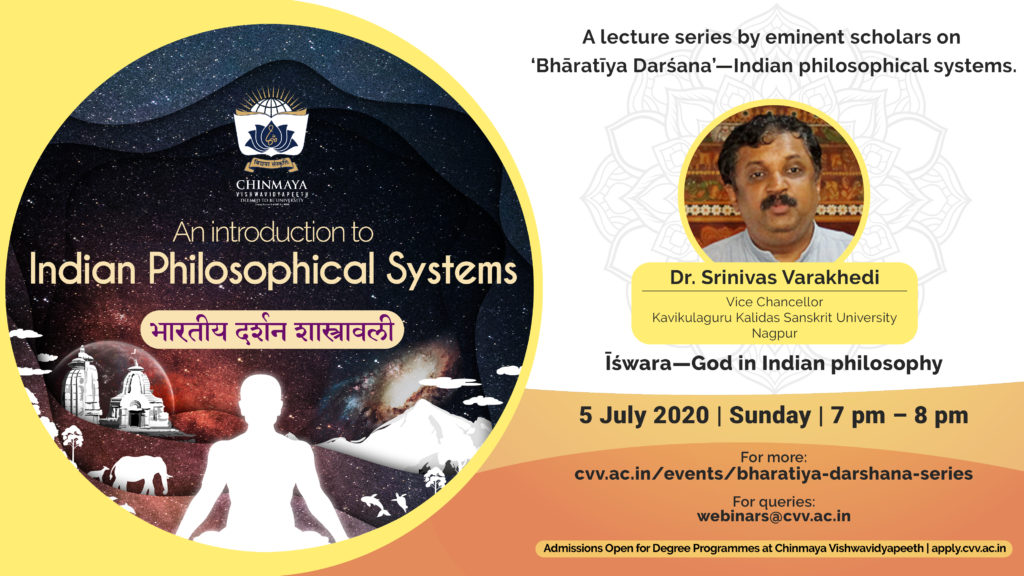
Dr. Varakhedi is the Vice Chancellor of the Kavikulaguru Kalidas Sanskrit University; Professor and Dean of Shastra Faculty in Karnataka Samskrita University. He is a member of various committees and academic councils and has more than thirty publications in national and international journals. Dr. Varkhedi has been awarded the ‘Maharshi Badarayan Vyas Samman’ by the President of India and the ‘Swami Chinmayananda Research Gold medal’.
He very emphatically brought out the following aspects:
- God is not an imagination but a reality in Indian philosophy.
- The concept of God emerges from three (independent) aspects—
- Every effect has a cause; hence this creation must also have a creator.
- The universe is but a reflection of an ultimate reality (bimba-pratibimba) and
- There must be something more perfect than the universe which is God (Pūrṇattva).
- The Earliest and the most comprehensive definition of God is ‘Brahman’, mentioned in the Upaniṣads as Satyam (eternal); Jñānam (knowledge/consciousness) and Anantam (limitless).
- Later the darśanas and purāṇas adopted specific aspects of this Brahman into their doctrines and philosophical systems.
- Children must be inducted into God through interesting purāṇic stories like that of Prahlāda that will instill in them love and respect towards God.
All in all an amazing exposition of the concept of ‘God/ Īśwara’ in our philosophy.
Session 7: ‘Yoga Darśana﹘What it is and what it is not’ by Dr. Veena Londhe.
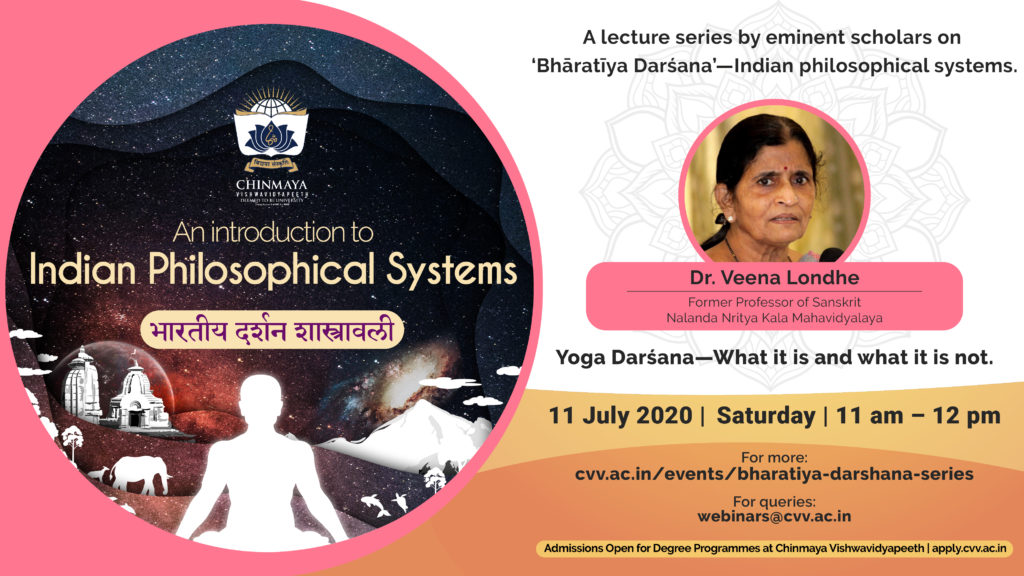
Dr. Veena Londhe is the former Professor of Sanskrit in Nalanda Nritya Kala Mahavidyalaya & Visiting faculty at University of Mumbai. She is a trained Yoga teacher actively engaged in propagating “Alternate Therapy of Space, Time and Motion” and conducts workshops/ lectures and treats patients through this therapy. She has done a course in Neuroscience of Yoga with eminent doctors in Pune. She has also authored the book “Interpreting Patanjali’s Yoga Darshana: Theory and Practice”
The session was a very engaging one which highlighted the key aspects of Yoga Darśana that typically go unnoticed in today’s times where Yoga has become synonymous only with physical exercises.
1) Speaker pointed out that āsana and prānāyāma are only 2 of the aspects of the ‘aṣṭāṅga yoga’ of Patañjali Maharshi. It is preceded by Yama & Niyama and succeeded by Pratyahara, Dharana, Dhyana and Samadhi.
2) Most of us typically ignore the Yama and Niyama which act as the foundation of the entire Yoga system. Yama includes Ahimsa, Satya, Asteya, Brahmacharya and Aparigraha while Niyama includes Saucha, Santosha, Tapas, Svadhyaya and Īśwara Pranidhana.
3) Yoga is a holistic system to be adopted as a way of life rather than a few hours of physical/ breathing exercises
4) Patanjali gives various techniques in his yoga sutras such as Kriya yoga, Practice of abhyasa & Vairagya, Ashtanga Yoga, Īśwara pranidhana through pranava japa & artha-bhavana etc. for different kinds of Adhikaris or people
5) The speaker took up a few Yoga sutras and explained the typical road blocks in achieving the ultimate state of ‘establishing in svarupa’ or nirvikalpa samadhi.
All in all a very enlightening lecture that brought great clarity to the listeners of what exactly ‘Yoga Darśana’ is.
Session 8: ‘Mimamsa﹘Relevance of Vedic rituals/ karmas in today’s context’ Dr. Gopala Desikan.
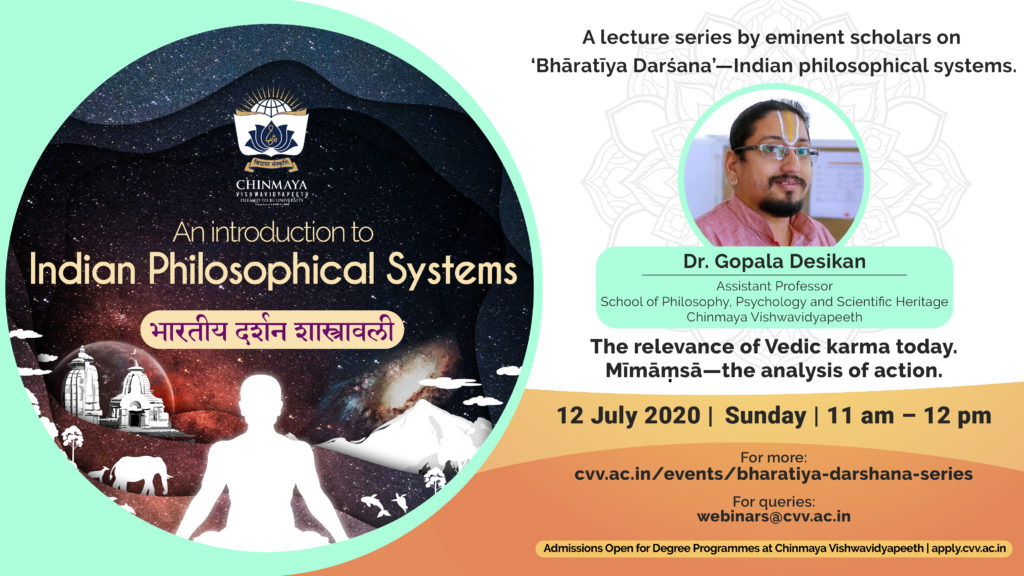
Dr Gopala Desikan is the Assistant Professor, School of Philosophy, Psychology & Scientific Heritage at Chinmaya Vishwavidyapeeth; Also an “Acharya” in Mimamsa and Nyaya with Ph.D. in Navya Nyaya, he has received several awards such as Vidwatpravara & Vidwanmani and attends traditional Vakyartha Sadas.
Mimamsa itself means analysis – of what? Of the Vedas. While Purva Mimamsa (popularly called just Mimamsa) analysed the Karma-kanda (ritualistic portion) of the Vedas, the Uttara Mimamsa (popularly called Vedanta) analysed the Jñāna-Kanda portion.
1) The speaker brought out the point that the main difference between these two Darśanas and the others is that they consider the authority (Pramana) of the Srutis as ultimate.
2) Mimamsa played a major role in resurrecting the Vedic dharma which was deteriorating due to the wide spread following of Nastika Darśana like Buddhism and Jainism.
3) Main ‘subject matter’ of Mimamsa is Dharma which is nothing but following the ‘injunctions’ (Vidhi) as laid down by the Vedas.
4) By following these injunctions, the doer gets the intended result provided these are performed by the intended adhikaris in the prescribed way.
5) Mimamsa also analyses the various types of Karma and their results.
6) As regards the non-performance of many of these rituals in today’s times, the speaker emphatically mentioned that one of the major reasons of this is not having conviction (born out of deep thinking) in the words of the Vedas (Veda apramanya bhrama).
7) The Vedic karmas are relevant even for today’s times but need to be properly studied & understood before discarding as irrelevant.
Session 9: ‘Introduction to Vedānta and Discussion on Śaṅkara Vedānta’ by Dr. Shakuntala Gawde.
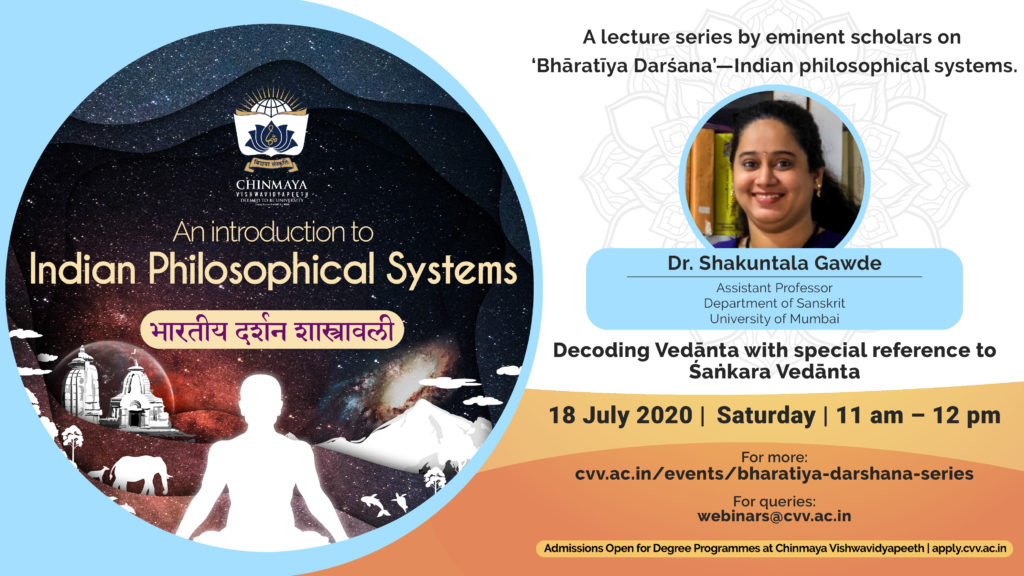
Dr. Shakuntala Gawde is an Assistant Professor at the Department of Sanskrit, University of Mumbai. Her doctoral work was on ‘Eschatology in Vedic Literature Compared with Western Philosophy’. She has several research papers and articles to her credit published in renowned journals and presented at national and international seminars.
The speaker gave a beautiful introduction to Vedānta Darshana, explained the five prominent schools of Vedānta and then delved deeper into the Kevala Advaita or Sankara Vedānta.
The key points discussed in the session were:
- Vedānta (Veda + anta) is so called because it comes towards the end of the Vedic literature. It also indicates the culmination of the Vedic thought.
- While it primarily refers to the Upaniṣads, it also includes the Brahmasūtras and the Bhagavad Gītā that further elaborate on the message of the Upaniṣads. Together these are called Prasthāna-traya—the three defining texts of Vedānta.
- It was Śrī Śaṅkara who first wrote a commentary on all three and then onwards it became a norm for an ācārya of Vedānta to write a commentary on the Prasthāna-traya.
- The Prasthāna-traya was interpreted differently by different ācāryas which led to the emergence of different schools of Vedānta, five of them being the most prominent—Kevala Advaita of Śaṅkara, Viśiṣṭa Advaita of Rāmānuja, Dvaita of Madhva, Dvaita Advaita of Nimbarka and Śuddha Advaita of Vallabha.
- Except for Kevala Advaita, all the other schools are Vaiṣṇavite in nature.
- The speciality of Śaṅkara Vedānta is that it relies only on the śruti or Veda pramāṇa for explanations. Later, ācāryas started adopting the Purāṇas, lesser known Upaniṣads etc. also as pramana.
- Śaṅkara also employs tarka or logic to explain the statements of the Upaniṣads.
- The key purport of Śaṅkara Vedānta is ‘Brahman is the ultimate reality, jagat or the world is only an appearance due to ignorance and the individual jīva is nothing but Brahman’.
- Hence, knowing and firmly establishing oneself in one’s true nature as Brahman is liberation.
- One can get liberated even with a physical body and this is called jīvan mukti.
In a short span of 90 minutes, the speaker provided extreme clarity and covered the key aspects of the topic.
Session 10: ‘Rāmānuja Vedānta’ by eminent scholar Dr. Gauri Mahulikar
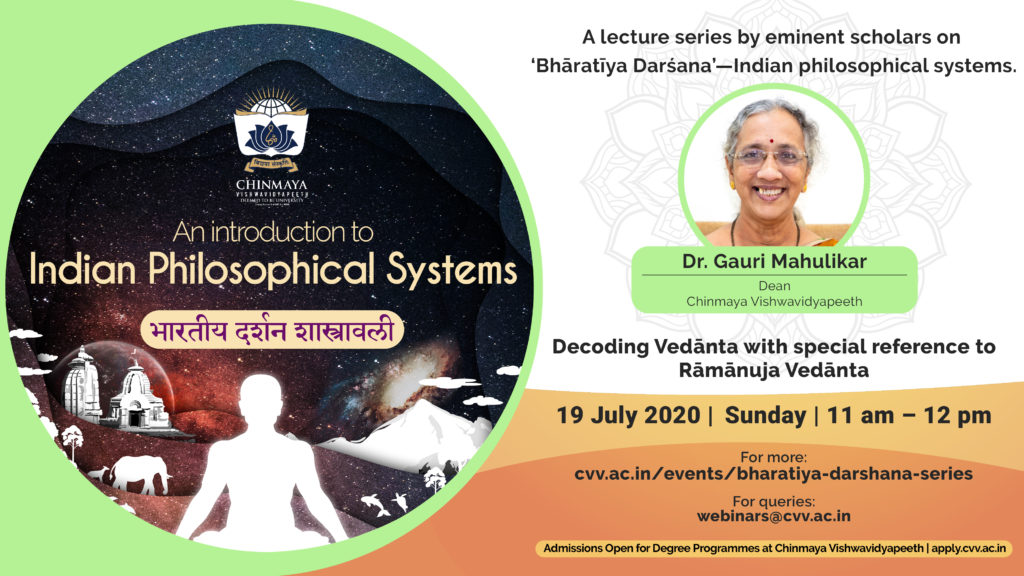
Dr. Gauri Mahulikar is the Dean of Chinmaya Vishwavidyapeeth. She was the Gurudev Tagore Chair of Comparative Literature Professor and former Head of Department of Sanskrit at the Mumbai University. Dr. Mahulikar has several books and research articles in English, Marathi, Hindi and Sanskrit to her credit. She has given lectures at various national and international venues, seminars and conferences and has been decked with several awards!
The speaker gave a scholarly and lucid exposition of Rāmānuja Vedānta that kept the audience engaged throughout.
The key points discussed in the session were:
- The Śrī Sampradāya began with the Alwars and was later propagated by ācāryas such as Yamunācārya. In this lineage came Rāmānujācārya who took refuge in three sources (Tri śaraṇa) for establishing Vishishta Advaita Vedānta, i.e. Sruti, Smriti (which includes the Puranas and Agamas) and Pasurams of the Alwars.
- In this system, jiva and jagat are but attributes (visheshana) of the supreme Brahman i.e. Vishnu, just as a drop of water is part of the ocean. Also, the water in the drop and the ocean has the same nature—hence Advaita. Thus, Vishishta Advaita.
- Jagat (world of plurality) is considered real as it is an attribute of Brahman who is real.
- Jiva is a small aspect of Ishwara and hence is different from Him. Jiva can never become one with Him—hence there cannot be sayujya mukti. Maximum possible mukti is salokya, sarupya or samipya.
- Prapatti, i.e. extreme state of bhakti, and sharanagati, i.e. complete surrender, are important means to moksha.
- Brahman is none but Bhagavan i.e. one possessed of Bhaga (the six attributes). He is the one who nourishes, sustains and resides in all.
- Rāmānuja reinterpreted the Mahavakyas e.g. Tat tvam asi is not ‘You are that’, instead ‘tadiyah tvam asi’ i.e. ‘You belong to Him’.
- We thus see that the ācāryas, from Sankara to Vallabha, have moved from the abstract to the concrete.
Dr. Mahulikar ended the talk with a verse she had composed on Rāmānujācārya on the occasion of his 1000th birth anniversary in 2017.
Session 11: ‘Madhva Vedanta’ by Dr. Prathosh A. P.

Dr. Prathosh is an Assistant Professor at the Department of Electrical Engineering, IIT Delhi. He has a Ph.D. from IISc. Dr. Prathosh belongs to the Madhva Parampara and participates in Vakyartha Sabhas particularly in Indian epistemological and Vedantic systems including Advaita, Dvaita and Bauddha.
The speaker gave a scholarly exposition of Madhva Vedanta.
Key points discussed in the session were:
- Though we commonly refer to this school as Dvaita-Vedanta, Madhvacharya himself called it Tattva-vada because he believed that the world and beings are all ‘real’.
- He also believed that jiva, jagat and Ishwara have innate differences between them and can never be the same. This he called pancha-bheda, i.e. five kinds of differences between (i) jiva and jagat (ii) one jiva and another jiva (iii) jiva and Ishwara (iv) jagat and Ishwara (v) one aspect of jagat and other aspects of jagat.
- He also believed that every jiva has an innate capacity/capability and this is different for every jiva. Hence, every jiva must aim to attain the fullest potential according to his/her capability.
- Thus liberation or moksha also has taratamya (gradation) based on the capability of the jiva.
- The Madhva parampara also gave rise to the Dasa parampara which spread the message of Madhva to the masses through their songs.
Session 12: ‘Vallabha Vedanta’ by young scholar Maitri Goswami
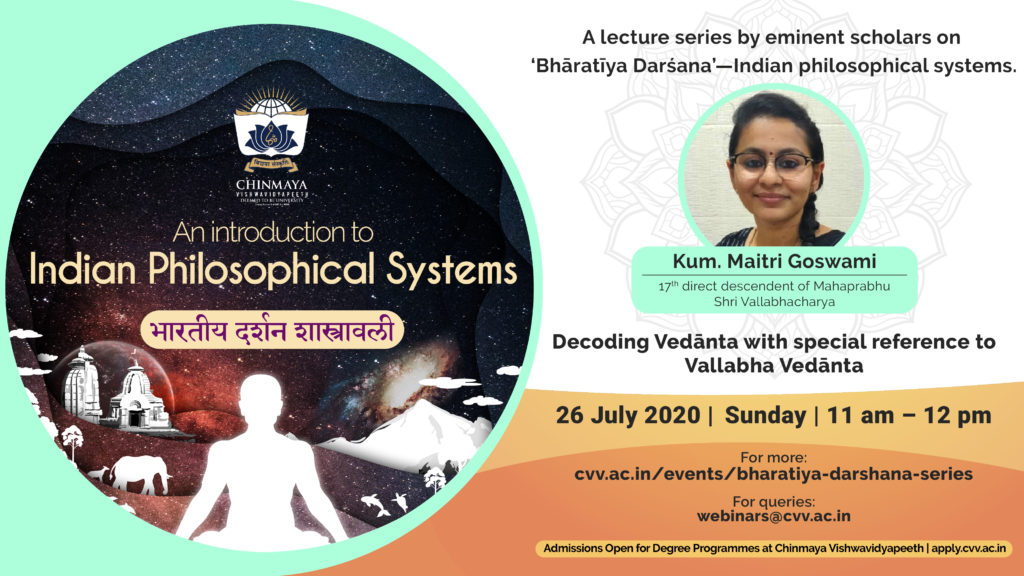
Maitri is the 17th direct descendent of Mahaprabhu Shri Vallabhacharya. She learnt all the traditional scriptures of Pushtimarga from her father Sri Sharad Goswami and her revered guru Goswami Shri Shyam Manoharji. Maitri is the founder member of Sri Vallabhacharya Vidyapeeth and in accordance with her duties towards her sampradaya, she has been preaching the scriptures written by Mahaprabhu Shri Vallabhacharya and Vedic philosophy.
The speaker gave a scholarly and lucid exposition of the Vallabha Vedanta. The key points discussed in the session were:
- The speaker started with a brief account of the life of Vallabhacharya and the message given by Lord Jagannatha.
- Vallabhacharya considered the Bhagavatha Purana as the fourth major Pramana along with the Upanishads, Bhagavad Gita and Brahmasutras.
- Brahman created the world by His leela. He is both, the material and the efficient cause of the world just like gold and ornaments.
- Thus, because that same Brahman created and became this Universe, this school is called Suddha Advaita as all of us have suddha Brahman in us. It is also called Tadatmya-vada.
- This supreme Brahman is Lord Sri Krishna who created the trinity of Brahma, Vishnu and Shiva, as well as the different incarnations along with all jivas.
- Bhakti or devotional service to the Lord is the ultimate path to liberation—nava vidha bhakti.
- This is possible only through the grace of the Lord.
Session 13: ‘Message of the Upanishads for Modern Education’ by eminent scholar Dr. K. Ramasubramanian
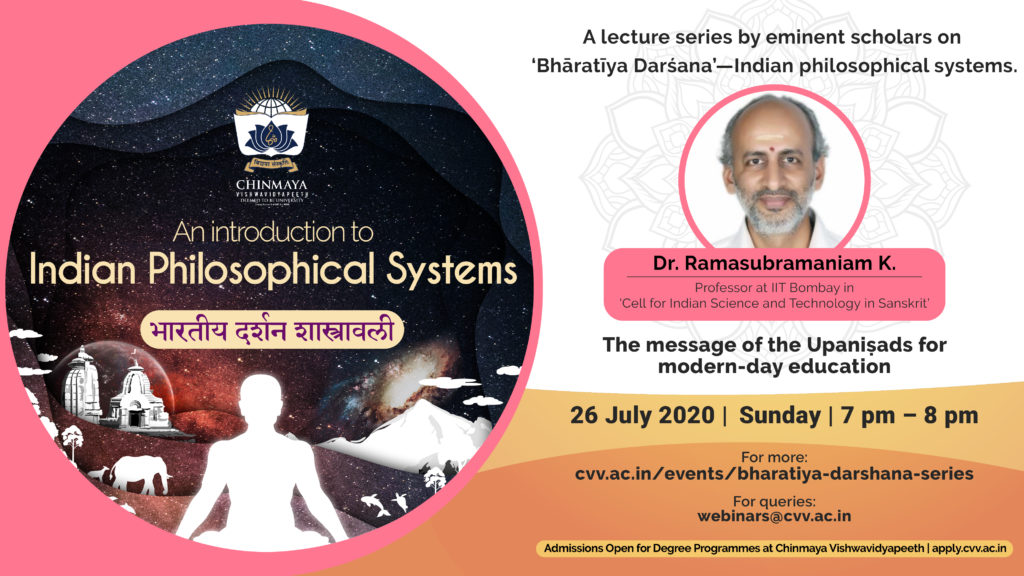
Dr. K. Ramasubramanian is a Professor at IIT Bombay in the ‘Cell for Indian Science and Technology in Sanskrit’. He has a doctorate in Theoretical Physics, a Bachelor’s degree in Engineering and a Master’s degree in Sanskrit. He was awarded the ‘Maharshi Badarayan Vyas Samman’ by the President of India in 2008 amongst many other awards. He is a member of the Central Sanskrit Board.
The speaker expounded on the key message of the Upanishads to be adopted for modern education.
The key points discussed in the session were:
- He started with the story of the Chhandogya between Aruni and his son Svetaketu. When after 12 years of education, Svetaketu returns home with pride and conviction that he’s learnt whatever is to be learnt, Aruni puts an end to his pride by asking him about Brahman. The speaker pointed out that the ultimate message of the Upanishads is to ‘Know our true nature as Brahman’.
- In this journey of knowledge, the student must have humility or vinayam which is fundamentally lacking in the current education system. The speaker illustrated this from episodes of Brihadaranyaka.
- In addition to humility, a student must cultivate three qualities—damyata i.e. not taking oneself too seriously/being tranquil; datta i.e. sharing with others and dayadhvam i.e. compassion towards others.
- Parents who wish to inculcate these values in their children must first practice them.
- Also, the need of the hour is to teach the students the ‘right’ thing through love and affection, employing appropriate means rather than not conveying the right message fearing repercussions.
All in all, a fantastic evening and a beautiful concluding lecture for the series.
The journey that began a month earlier with an introduction to Darshana Shastra and the materialist philosophy ended with the ‘knowledge of one’s true Self’. This in a way symbolised the journey of the sadhaka itself.
This lecture was followed by a valedictory function wherein participants shared their feedback and memories of the various sessions. This was followed by the valedictory address of Prof. Nagaraj Neerchal, Vice Chancellor of CVV, wherein he applauded the efforts undertaken for this series and assured to give a proper conclusion to this series through the release of a publication summarising the session contents. The session concluded with a vote of thanks by Dr. Gauri Mahulikar, Dean of CVV.

